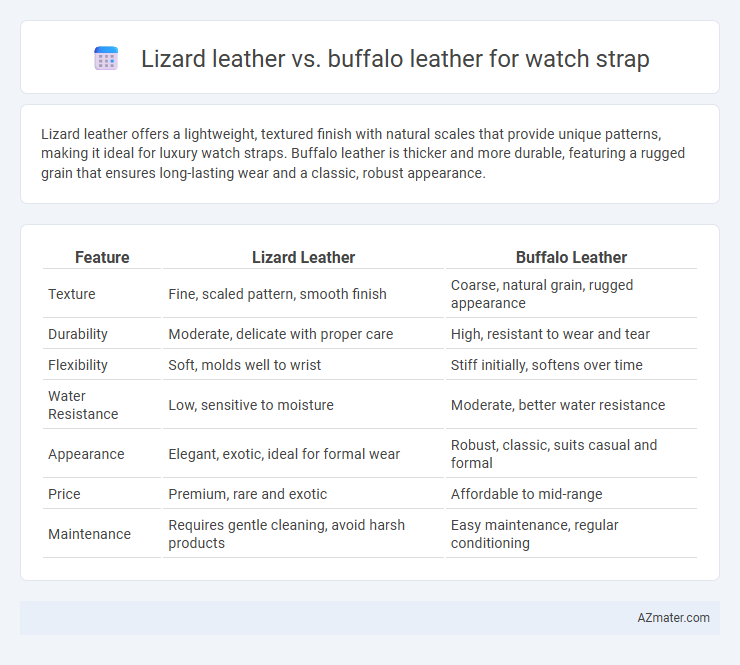Lizard leather offers a lightweight, textured finish with natural scales that provide unique patterns, making it ideal for luxury watch straps. Buffalo leather is thicker and more durable, featuring a rugged grain that ensures long-lasting wear and a classic, robust appearance.
Table of Comparison
| Feature | Lizard Leather | Buffalo Leather |
|---|---|---|
| Texture | Fine, scaled pattern, smooth finish | Coarse, natural grain, rugged appearance |
| Durability | Moderate, delicate with proper care | High, resistant to wear and tear |
| Flexibility | Soft, molds well to wrist | Stiff initially, softens over time |
| Water Resistance | Low, sensitive to moisture | Moderate, better water resistance |
| Appearance | Elegant, exotic, ideal for formal wear | Robust, classic, suits casual and formal |
| Price | Premium, rare and exotic | Affordable to mid-range |
| Maintenance | Requires gentle cleaning, avoid harsh products | Easy maintenance, regular conditioning |
Introduction: Lizard Leather vs Buffalo Leather for Watch Straps
Lizard leather offers a unique texture with fine, intricate scales that provide a sophisticated and lightweight option for watch straps, prized for its elegance and durability. Buffalo leather is thicker and more robust, known for its strength, resilience, and natural grain patterns that provide a rugged yet refined look. Choosing between lizard and buffalo leather depends on preferences for texture, durability, and style, with lizard emphasizing luxury and buffalo delivering sturdiness.
Aesthetic Appeal and Texture Comparison
Lizard leather watch straps offer a distinctive, fine-scale texture that exudes elegance and luxury, ideal for those seeking a refined and exotic appearance. Buffalo leather, known for its robust grain and natural rugged patterns, provides a more durable and bold aesthetic with a softer, thicker feel. Both materials enhance watch straps differently, with lizard leather emphasizing sophistication and buffalo leather highlighting strength and character.
Durability and Longevity of Lizard vs Buffalo Leather
Lizard leather offers a unique texture and moderate durability but tends to be thinner and less resistant to daily wear compared to buffalo leather. Buffalo leather stands out for its exceptional toughness, thickness, and high resistance to scratches and stretching, making it ideal for long-lasting watch straps. The dense fiber structure of buffalo leather ensures superior longevity, while lizard leather may require more careful maintenance to maintain its appearance over time.
Comfort and Flexibility on the Wrist
Lizard leather offers superior flexibility and a lightweight feel, conforming smoothly to the wrist for enhanced comfort during extended wear. Buffalo leather provides greater durability and a robust texture, although it may initially feel stiffer and require a break-in period to achieve optimal flexibility. Both materials balance comfort differently, with lizard leather excelling in softness and buffalo leather in long-term resilience for watch straps.
Water Resistance and Maintenance
Lizard leather watch straps offer moderate water resistance due to their smaller, tightly packed scales, making them less prone to water damage compared to other exotic leathers; however, they still require careful maintenance and should be kept dry to preserve their texture and durability. Buffalo leather straps provide superior water resistance thanks to their dense and thick hide, making them ideal for daily wear and exposure to moisture, while being easier to maintain with regular conditioning to prevent drying and cracking. Choosing between lizard and buffalo leather depends on the balance between aesthetic preference and practical considerations like water exposure and upkeep.
Weight: Lightweight vs Heavier Options
Lizard leather watch straps are prized for their lightweight feel, offering superior comfort especially during extended wear. Buffalo leather straps, by contrast, are heavier and provide a more robust, substantial presence on the wrist. Choosing between lizard and buffalo leather depends on whether the wearer prefers a delicate, light touch or a durable, weighty option for daily use.
Cost and Value for Money
Lizard leather watch straps generally cost more due to their exotic texture and limited availability, offering a unique, luxurious appearance that can justify the higher price for collectors. Buffalo leather straps tend to be more affordable while delivering excellent durability and a robust feel, making them a cost-effective choice for everyday wear. Evaluating value for money, buffalo leather is ideal for long-term use without frequent replacement, whereas lizard leather appeals to those prioritizing distinctive aesthetics and exclusivity.
Availability and Color Choices
Lizard leather watch straps offer limited availability due to the scarcity of lizard skins and the intricate processing required, resulting in mostly natural earthy tones like browns and tans. Buffalo leather is widely available with a larger supply chain, allowing for a broader spectrum of color choices including black, dark brown, and custom dyed options. The greater accessibility of buffalo leather makes it a popular choice for watch straps requiring diverse color selections.
Hypoallergenic Properties and Skin Sensitivity
Lizard leather is highly suitable for watch straps due to its natural hypoallergenic properties, reducing the likelihood of allergic reactions and irritation for sensitive skin. Buffalo leather, while durable and robust, may contain more natural oils and proteins that can sometimes trigger sensitivities in individuals with reactive skin. Choosing lizard leather offers a smoother, less porous surface that minimizes skin contact allergens, making it ideal for those prone to allergies or skin sensitivities.
Environmental Impact and Ethical Considerations
Lizard leather, derived from reptiles, involves sourcing from wild or farmed lizards, raising concerns about biodiversity impact and the sustainability of exotic species populations. Buffalo leather, typically a byproduct of meat production, often presents a lower environmental footprint due to integrated livestock farming, but it contributes to broader issues like methane emissions and land use. Ethical considerations include the treatment of animals in farming or hunting practices, with buffalo leather generally regarded as more ethically viable due to regulated livestock management compared to the more variable standards in reptile trade.

Infographic: Lizard leather vs Buffalo leather for Watch strap
 azmater.com
azmater.com